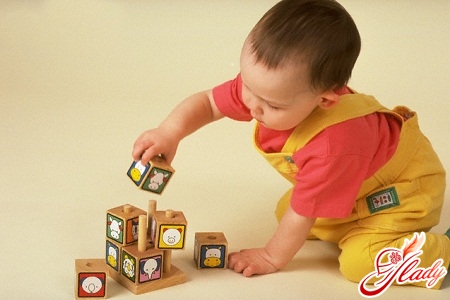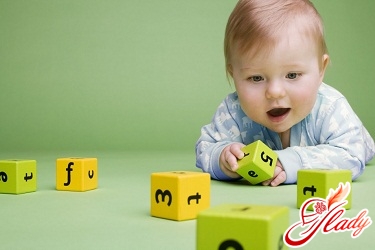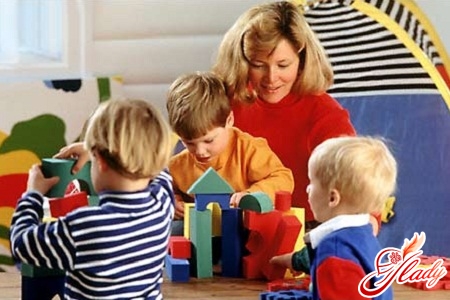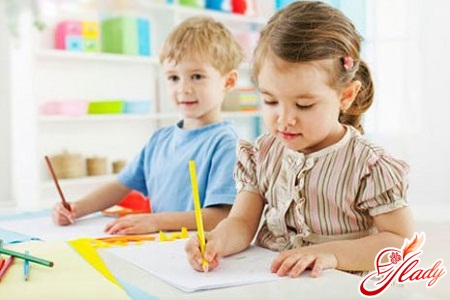 In recent years, more and more parents are askingперед собой задачу вырастить из своего ребенка настоящего гения. Причем начинают заниматься со своим малышом практически с его рождения. Развитие речи у детей раннего возраста, логического мышление, одновременное изучение сразу нескольких языков, математических и гуманитарных наук. Причем нагрузка на ребенка напрямую зависит от амбиций его родителей. Для кого-то четырехлетний малыш, декламирующий стихотворения Агнии Барто – повод для искренне родительской гордости, а кто-то не доволен, что трехлетний кроха иногда путается в дробях. У раннего развития детей существует очень много как сторонников, так и противников. Одни родители и педагоги утверждают, что все необходимо вкладывать в ребенка, начиная с самого раннего детства – именно это послужит залогом того, что ребенок вырастет образованной и одаренной личностью. А другие родители утверждают, что подобное увлечение различными методиками раннего развития напрочь лишает ребенка детства и крайне негативно влияет на состояние его психики и на всю нервную систему. Сложно однозначно сказать, кто же из них прав, однако ясно одно. Ребенок – это не красивый садовый цветок. Для его развития недостаточно просто обеспечивать физиологические потребности организма – еда, сон, одежда, состояние здоровья. В любом случае, для успешного и гармоничного развития ребенка с ним следует заниматься. Причем заниматься должны именно родители. Поверьте, ни одна развивающая телепередача или компьютерная программа не способная помочь ребенку раскрыть все свои способности. Конечно же, мы не призываем вас начать изучение уругвайского языка с полугодовалым крохой, либо объяснять, что такое интегралы, трехлетнему малышу. Однако некие базовые знания и навыки дать ребенку родители просто обязаны. Для того чтобы понять справедливость данного утверждения, родителям просто достаточно вспомнить себя в детском возрасте. Да и. в принципе, не только в детском – ведь чувства не зависят от того, большой ты или маленький. Наверняка, практически каждый человек хотя бы раз в жизни попадал в ситуацию, когда ему приходилось чувствовать себя крайне неловко из-за того, что он чего-либо не знает. Смущение – это одна из наименее негативных эмоций в данной ситуации. А ведь в том случае, если по тем или иным причинам подобные ситуации случаются регулярно, очень высока вероятность того, что у ребенка с самого раннего детства начнет развиваться комплекс неудачника и пропадет любая уверенность в себе. А учитывая тот факт, что большинство современных родителей начинает заниматься со своими детьми очень и очень рано, вряд ли ребенку на детском утреннике удастся кого-либо удивить стихотворением Агнии Барто. Данная статья призвана помочь разобраться в огромном многообразии различных развивающих методик для детей тем родителям, которые хотят, чтобы их ребенок был развит всестороннее, а значит, чувствовал себя уверенно в любой ситуации. Кроме того, не стоит также забывать и о том, что развитые и уверенные в себе дети гораздо проще адаптируются в обществе, учатся четко обозначать свои цели и достигать их. Таким детям и во взрослой жизни будет гораздо проще и комфортнее, чем их сверстникам, коротавшим в детстве время перед телевизором.
In recent years, more and more parents are askingперед собой задачу вырастить из своего ребенка настоящего гения. Причем начинают заниматься со своим малышом практически с его рождения. Развитие речи у детей раннего возраста, логического мышление, одновременное изучение сразу нескольких языков, математических и гуманитарных наук. Причем нагрузка на ребенка напрямую зависит от амбиций его родителей. Для кого-то четырехлетний малыш, декламирующий стихотворения Агнии Барто – повод для искренне родительской гордости, а кто-то не доволен, что трехлетний кроха иногда путается в дробях. У раннего развития детей существует очень много как сторонников, так и противников. Одни родители и педагоги утверждают, что все необходимо вкладывать в ребенка, начиная с самого раннего детства – именно это послужит залогом того, что ребенок вырастет образованной и одаренной личностью. А другие родители утверждают, что подобное увлечение различными методиками раннего развития напрочь лишает ребенка детства и крайне негативно влияет на состояние его психики и на всю нервную систему. Сложно однозначно сказать, кто же из них прав, однако ясно одно. Ребенок – это не красивый садовый цветок. Для его развития недостаточно просто обеспечивать физиологические потребности организма – еда, сон, одежда, состояние здоровья. В любом случае, для успешного и гармоничного развития ребенка с ним следует заниматься. Причем заниматься должны именно родители. Поверьте, ни одна развивающая телепередача или компьютерная программа не способная помочь ребенку раскрыть все свои способности. Конечно же, мы не призываем вас начать изучение уругвайского языка с полугодовалым крохой, либо объяснять, что такое интегралы, трехлетнему малышу. Однако некие базовые знания и навыки дать ребенку родители просто обязаны. Для того чтобы понять справедливость данного утверждения, родителям просто достаточно вспомнить себя в детском возрасте. Да и. в принципе, не только в детском – ведь чувства не зависят от того, большой ты или маленький. Наверняка, практически каждый человек хотя бы раз в жизни попадал в ситуацию, когда ему приходилось чувствовать себя крайне неловко из-за того, что он чего-либо не знает. Смущение – это одна из наименее негативных эмоций в данной ситуации. А ведь в том случае, если по тем или иным причинам подобные ситуации случаются регулярно, очень высока вероятность того, что у ребенка с самого раннего детства начнет развиваться комплекс неудачника и пропадет любая уверенность в себе. А учитывая тот факт, что большинство современных родителей начинает заниматься со своими детьми очень и очень рано, вряд ли ребенку на детском утреннике удастся кого-либо удивить стихотворением Агнии Барто. Данная статья призвана помочь разобраться в огромном многообразии различных развивающих методик для детей тем родителям, которые хотят, чтобы их ребенок был развит всестороннее, а значит, чувствовал себя уверенно в любой ситуации. Кроме того, не стоит также забывать и о том, что развитые и уверенные в себе дети гораздо проще адаптируются в обществе, учатся четко обозначать свои цели и достигать их. Таким детям и во взрослой жизни будет гораздо проще и комфортнее, чем их сверстникам, коротавшим в детстве время перед телевизором.
Why up to three years?
Why is early development so important?child? Maybe it makes sense not to burden the baby from the very first year of life, or even earlier, but to wait at least until the first grade? However, numerous studies by scientists and child psychologists have reliably proven that the best time for the perception and assimilation of new information is precisely the age of up to three years. At this age, the child's brain is able to perceive and remember such a volume of information that an adult will never be able to cope with. Are you still afraid of the prospect of depriving your child of a happy and cloudless childhood? Perhaps you are right in some ways. But try to answer the simplest question - what exactly is a happy childhood up to about three to five years of age? It is in the natural knowledge of the world. And it is on the shoulders of parents that the task lies to give the child answers to all his numerous "Why", "Why", "Where", "What" and "How". You can brush off the child, justifying yourself with constant busyness and fatigue, or get rid of the baby with monosyllabic, terse answers. Or you can spend a little time and not just give an answer, even a detailed one, but teach the child to analyze and independently find answers to certain questions. But, of course, the child should remember that you are always there and will always come to his aid. And it is precisely in order to form such a way of thinking in the baby that early childhood development methods are needed.
Where to start?
Have you read this far?Obviously, you have decided that you and your child still need early development. And a completely logical question arises - where to start? After all, child development is a very, very serious matter. And this means that it is necessary to approach this issue with all responsibility, because the wrong actions of parents can only cause harm - the child may completely lose interest in learning about the world around him. That is why psychologists and teachers advise parents not to engage in amateur activities, but to use one of the many professional methods that have been tested and proven themselves well. Sometimes it is very, very difficult for inexperienced parents to do this on their own. Of course, below we will describe each of the methods in more detail. But if something remains unclear to you, or you cannot give preference to one or another method of early child development, you should seek help from psychologists and teachers. Today, there is a huge number of various psychological tests and other very reliable methods that allow psychologists to identify the inclinations, abilities and mindset of even very young children, starting from about six months of age. With this information, parents and a psychologist will be able to choose the most appropriate method for developing the child. And another important detail, which no one talks about, and, as a rule, absolutely does not take into account, is the child's health. Of course, if the child often catches colds, it is at least stupid to refuse early development. But if the baby suffers from one or another serious disease, you should not burden him too much. In this case, it would be wiser to consult with the baby's attending physicians, who are able to objectively assess the situation and the possible harm that excessive mental stress can cause the baby. Of course, parents may be upset in this case, but they should not do this. Whatever the case, the child's health is above all else - it should be at the forefront of everything. And development will not go anywhere - after all, your child in any case continues to actively develop every minute of his life. And you will definitely make up for lost time, albeit a little later. After all, the fact that information is best absorbed at the age of up to three years does not mean that after this age the child has no chance to catch up with those kids who started studying earlier. You will just have to spend a little more time and effort on this, but there is nothing impossible or unrealistic in this task.
The Glen Doman Method
The very first system of early child development,о которой пойдет речь ниже – это методика одного из основателей Института раннего развития ребенка, расположенного в Филадельфии. И названа она в его честь – методика Глена Домана. Как и у практически любой другой методики раннего развития ребенка, у нее есть как свои ярые поклонники, так и не менее ярые противники. Уже не один год об этой методике спорят педагоги, детские психологи, родители, пишут различные СМИ. Однако, несмотря на все многочисленные споры и разногласия, и та, и другая сторона единогласно признают, что эта методика на сегодняшний день является одной из самых эффективных. И первое, что необходимо знать родителям – это тот факт, что изначально данная методика разрабатывалась, как эффективная система обучения детей, так или иначе отстающих в эмоциональном и психическом развитии. Однако если сама методика придется вам по душе, этого пугаться не стоит. Уже не первый год данную систему во всем мире с потрясающим успехом используют для раннего развития совершенно здоровых деток. Поэтому не стоит отказываться от действительно хорошего метода только из-за каких-то предрассудков. На чем же основан принцип данного метода? Именно на том, что у маленьких детей развито лучше всего – на зрительном восприятии. Для того чтобы вы могли начать заниматься с ребенком, вам необходимы специальные карточки. Эти карточки можно купить уже готовые – они продаются во многих специализированных магазинах, торгующих товарами для детского развития и творчества. А можно пойти по более сложному пути и сделать их самостоятельно. Для этого вам понадобится белая бумага либо, что еще лучше, картон — он гораздо прочнее, а значит, и карточки будут намного долговечнее. Для первого месяца занятий достаточно 15 – 20 штук, далее по мере усвоения ребенком материала их количество необходимо постепенно увеличивать. Насколько увеличивать, вы поймете по своему ребенку. Для начала выберите тему занятия. На прямоугольный лист картона необходимо наклеить изображение, соответствующее выбранной теме. После этого вам понадобится линейка и красный маркер. Обведите изображение маркером, взяв его в своеобразную рамку. А под изображением красными печатными буквами напишите название того, что нарисовано – это обязательное условие, практически основа всей методики. Для чего же они нужны? Все очень просто – благодаря рамке, внимание ребенка фокусируется точно на рисунке. Хотя в том случае, если рисунок достаточно четкий и контрастный, можно опустить момент с рамкой и не рисовать ее. Почему именно красный цвет? Ответ также очень прост – ученым давно удалось доказать, что красный цвет сильнее остальных оказывает раздражение на рецепторы человеческого глаза. А значит, и на кору головного мозга воздействие красного цвета также в разы интенсивнее. Именно благодаря этим факторам информация в головном мозге ребенка отложится гораздо легче и, что немаловажно, гораздо быстрее, чем если бы использовался какой-либо другой цвет. Эти карточки с изображением различных предметов необходимо показывать ребенку, позволив зафиксировать на них взгляд не более чем на несколько секунд. В это время взрослый человек, занимающийся с ребенком, должен четко называть вслух название изображенного на карточке предмета. На картинке может быть изображено что угодно – все зависит от фантазии и предпочтений родителей. Возможно, вы захотите просто познакомить ребенка с окружающим миром? Тогда на картинках может быть изображено что угодно – посуда, мебель, одежда. А возможно, вы мечтаете о том. Чтобы вырастить юного биолога? Тогда на карточках могут быть изображены различные цветы, грибы, животные. Юный химик? Да, в общем, тоже вполне реально, только следите за тем, чтобы название тех или иных химическим элементов на карточках было написано правильно. А если серьезно, то с помощью этой методики можно научить ребенка не только узнавать и называть различные предметы, но и писать, и даже считать. Можно приобрести или сделать карточки с алфавитом, а можно сразу с различными словами, состоящими из четырех – пяти букв. То же самое касается и цифр – вы можете нарисовать на карточках просто цифры, а можете небольшие предметы, в различном количестве на различных карточках, с подписанной внизу цифрой. Обратите внимание, что для достижения желаемого результата необходимо соблюдать несколько достаточно простых условий. Во-первых, заниматься с ребенком можно начинать так рано, как этого захотят родители – практически с конца первой недели жизни, когда малыш научится фокусировать взгляд на определенном предмете. Но и крайнего срока также нет – это можно начинать делать и в три года, и в пять лет. Положительный результат будет виден практически в любом случае. Во-вторых, обращайте внимание на то, в каком настроении находится малыш на момент начала очередного занятия. Ни в коем случае не начинайте занятие с плачущим или просто капризничающим малышом, в том случае, если он устал, хочет есть или спать. В данной ситуации никакую информацию малыш все равно усвоить будет не в состоянии, а вот негативные ассоциации с карточками могут закрепиться в его сознании с очень высокой долей вероятности – и в итоге родители получат эффект, полностью противоположный тому, к которому они стремились. В – третьих, продолжительность занятий также должна быть строго ограничена. Причем в каждом конкретном случае эта продолжительность может быть самой различной – у кого-то она будет равняться двум минутам, у кого-то – пяти, а кому-то и двадцати может быть мало. Хотя, конечно же, последний вариант встречается крайне редко – практически ни один из детей не в состоянии удерживать концентрацию внимания на протяжении столь длительного времени. А заканчивать занятия необходимо сразу же, как только ребенок начнет проявлять первые же признаки усталости или недовольства. Строго говоря, принцип действия данной методики очень и очень прост – ребенок видит надпись и картинку, тут же следует звуковое сопровождение. В итоге в памяти ребенка фиксируется и название, и визуальный ряд увиденного. Как правило, подобные занятия очень нравятся детям не зависимо от их возраста – ведь разглядывать интересные красочные картинки нравится каждому ребенку без исключения. 
Montessori Methodology
The following technique deserves to be mentioned,to be talked about - this is the early development system of Maria Montessori. This method is interesting in its own way, as it is based on a very unusual approach to the early development of the child. Its main principle and motto is "Help me learn everything on my own!" Simply put, its developer claims that the most optimal option for a child's development is independent development, initiative, identification of their needs and interests and, accordingly, their independent satisfaction. But, of course, it is almost impossible for a child to learn this on their own, without the help of an adult. Therefore, the primary task of parents is not only to create an appropriate environment for the child's development, in which he can achieve what he wants, but also to teach him a certain independence. This method excludes situations when an adult does something instead of a child, allegedly thereby setting an example for him. From the point of view of the author of this method, adults should build relationships with a child in such a way that the child can independently come to the solution of all the tasks set before him. This will help the child very quickly and fully realize that the child is an absolutely independent person, capable of solving certain issues on his own. It is very difficult to describe all the materials that are used for the development of a child using this method. However, all of them are aimed only at the child being able to define the goal before him, either achieve it, or independently understand that he is doing it wrong, and why he is not achieving what he has planned. A striking example of such materials are the toys of the "Sorter" series. They are probably in every family with small children: the toy itself, which has some form - a car, an animal, a house. And they have slots in which you need to insert small figures into the slots. Strictly speaking, the Montessori early childhood development system is more of a family lifestyle than a teaching method. Teachers and parents who use this system claim that each child is an absolutely unique individual, requiring not only respect from an adult, but also an equal relationship. And all children develop completely differently, which means that the attitude and approach to each specific child should be individual. By the way, recently there have been more and more state preschool institutions - kindergartens. The classrooms are equipped with development aids, and the main task of the educators is to help the child organize his activities in such a way that all the natural inclinations and abilities of the child can be fully revealed. As already mentioned above, the whole principle of this system is based on the fact that the child himself learns to find his mistakes, analyze them and correct them. There are several directions in which the child develops:
- Personal space
For the harmonious development of a child, he mustyou can get to know such adult and complex concepts as orderliness and personal space better at an earlier age. And adults don’t have to make any special efforts to do this. First, you need to explain to your child a simple truth – every thing has its place. Always make sure that your child puts all of his things in specific places. Believe me, very soon your child will do this automatically and always, as he will form a connection between “thing and place”. In addition, adults should remember that a child, just like any adult, has the right to his own personal space. Ideally, a child should have his own room or, at the very least, his own play area where he can hide and no one should disturb him there. At the same time, parents should teach their child that their parents also have their own personal space and respect this right.
- Practical skills
An equally important direction in this methodologydevelopment is the development of practical skills that the child will need in later life. Of course, all parents teach this without exception, but the question is - at what age? Supporters of the Montessori method teach basic self-care skills - tying shoes, cleaning shoes, fastening buttons and zippers, setting the table - to one and a half year old babies. No one tells them - you're still little, you can't do it, it's dangerous. Adults just teach babies how to properly handle this or that object. And you know what's most interesting? Of course, not the first time, but almost all babies quickly master all the necessary skills, which pleases their parents and amazes relatives, friends and others. And please note - success is possible only if the child is taught with real objects. A dropped cup with real water, and a wet floor that the baby can touch with his foot will teach him to be neat much faster than plastic toy dishes with imaginary water. Don't rush to snatch scissors, a needle or matches from a child's hands. Go up to the child, squat down so that you are on the same level with him, and ask him for the forbidden thing in a quiet, calm voice. As a rule, the child gets confused and meekly gives up what is required. After that, take the baby's finger and prick it with a needle or the sharp tip of the scissors, hold it over the flame for a couple of seconds. We can already sense the storm of indignation that these words caused in our readers. However, try to calm down and think for yourself - we are not asking you to prick the unfortunate child until he bleeds or burn him until he blisters. Just let him feel for himself what unpleasant sensations dangerous objects can cause. Believe me, no admonitions or suggestions will make any impression on a child under five or six years old - after all, for them the concept of "death" is still very, very abstract. Therefore, even if your little one looks at you with his little eyes and says: "Yes, Mommy, I understand everything", do not hope for this. It goes without saying that in no case should you leave dangerous objects in places accessible to a child. However, it is impossible to fully guarantee that the child will never get to the forbidden things if you turn away for just a second. And do you imagine the possible scale of the catastrophe if the child gets to them without your supervision? Therefore, it is much wiser to let the child understand all the danger and, most importantly at his age, all the unpleasant sensations associated with these objects.
- Sensory development
It is probably not worth repeating once again that,how important tactile sensations are for a child’s development. But the range of tactile sensations that is available to a child in everyday life is extremely small. And with the help of this technique, you will allow the child to get acquainted with the whole range of sensations. In addition, the child gets the opportunity to develop not only tactile sensations, but also taste, smell, temperature, get acquainted with the different sizes of objects and their weight. And it is not that difficult to do this. For the development of tactile sensations, various pieces of fabric will be very useful - leather, fur, knitwear, silk, and the like, pieces of twine, objects made of various materials - wood, plastic, iron, stone. In this situation, absolutely all available materials can be used - household items, various natural materials. Just turn around and look carefully - you will surely find something suitable. In addition, do not forget about such a wonderful developmental material as water. It provides a very wide field for the flight of fantasy. You can give your child small containers with water of different temperatures – this way the child will get acquainted with such concepts as cold and hot. Water can be placed in a mold and left in the freezer for some time – this way the child will learn that water has different properties and states. And if you buy gouache, water will become a practically inexhaustible source of inspiration – you can give it different shades, and colored ice cubes can delight absolutely any child. This stage of the child’s development is extremely important not only for his general outlook, but also necessary for a smooth and successful transition to the next stage of development – mathematical. It will be discussed a little below. Why is sensory development the previous stage? Everything is very simple – sensory development inevitably entails the development of logical thinking, the ability to absorb accurate information. Thus, for a child, mathematical concepts will not become something supernatural, beyond the scope, difficult to understand.
- Mathematical development
As a rule, with the help of this technique the childvery quickly masters mathematical concepts. To do this, parents should surround the child with numbers from almost all sides. First, constantly count together with the baby - with children under three years of age, teachers advise adding and subtracting within ten. Secondly, the child should constantly be surrounded by cards and pictures with numbers - visual memory also helps to remember numbers perfectly. And, thirdly, try to build events so that the child is forced to constantly make simple mathematical calculations. For example, instruct the little one to divide candies between family members, or ask him to bring a certain number of forks or spoons. It is generally accepted that a mathematical mindset, and accordingly, success in mathematics, is most often typical for boys. However, this method completely refutes this theory - the success of girls, provided that mathematical thinking is developed according to this method, is no less amazing than the success of boys. By the way, such children have practically no problems with academic performance in mathematics, either in elementary or high school.
- Language development
Of course, we can’t ignore this onean important area of early child development, such as language. A child is first and foremost a native speaker, which means that language development plays no less, and perhaps even more, a role for him than all other areas. Pay attention to the children around you - the higher the child's vocabulary, and the more correct and literate the speech, the higher his level of intellectual development. Moreover, in this situation, you need to start working with the child as early as possible - almost from the moment he is born. First, talk to the child constantly, even if you are sure that he is still too small and does not understand you. Explain to him every action. Are you dressing the baby? Tell him why you chose this particular suit, what color it is, and how beautiful the baby is in it. Are you bathing the baby? Tell him that the water is warm and pleasant, the soap smells like strawberries, and after bathing, a large, cozy and warm fluffy towel awaits the baby. Tell the baby a poem, sing him a song, tell him how much you love him. And do not think that these conversations are useless, because the baby is not yet able to understand a word. The most important thing is that he will certainly feel your love. And the words will certainly be deposited in the child's mind. And when the time comes, the baby will start talking, already having a good vocabulary. In addition, supporters of this method advise starting to introduce letters to older children. Moreover, they claim that the best effect will be achieved by a method of learning letters that is directly related to tactile sensations. You can buy relief letters in the store that are attached to a magnetic board, or cut them out of so-called velvet paper yourself. When teaching, guide your baby's finger along these letters, pronouncing each of them out loud. By the way, the following control is very useful. Scatter semolina, sugar or flour on the table in an even layer. Show your baby how fun it is to draw with a finger on such a "field" - he will certainly be happy to pick up your initiative. Believe me, there will be a lot of fun, but mothers should be prepared for the fact that cleaning will be a mandatory final chord. As the child memorizes all the letters without exception, you can begin to study syllables and even short words. By the way, teachers practicing such a method of early development claim that it is best to do this on a magnetic board. So if you still have not purchased such a magnetic alphabet, now is the time to worry about buying one. It is not difficult to find one - they are sold in almost any bookstore or in the stationery department.
- Natural Sciences
As the child grows up - approximatelyafter three years - parents should pay attention to those areas that have remained unnoticed until now - history, geography, the structure of the universe, after all. Without this information, the further harmonious development of the child becomes almost impossible. However, it is very difficult for parents to do this on their own. Therefore, it is much wiser in this situation to seek help from specialists. This visit will be extremely useful even if you do not have the opportunity to take your child to classes in specialized groups. The teacher will help parents understand in which direction he should move further, and how best to convey the necessary information to the child. In conclusion of the story about the Montessori method, in fairness it should be noted that despite all its positive aspects, it is very far from perfect in itself. As mentioned above, it is rather a way of life of the family and a principle of building relationships with the child. However, it is sometimes insufficient in itself for the comprehensive development of the baby, therefore, to achieve the best result, it should be combined with various other methods of early child development. These can be Doman cards, Montessori toys, and even Zaitsev cubes. As a rule, complex development brings more benefits. In addition to these described methods, there are other methods of child development. Which one is right for your child is up to the parents to decide. And it doesn’t matter at all whether it will be one of the popular ones or not – the attention from the parents will not be wasted anyway. And your baby will definitely be the most capable and smart – after all, that’s what early childhood development is for! We recommend reading:









